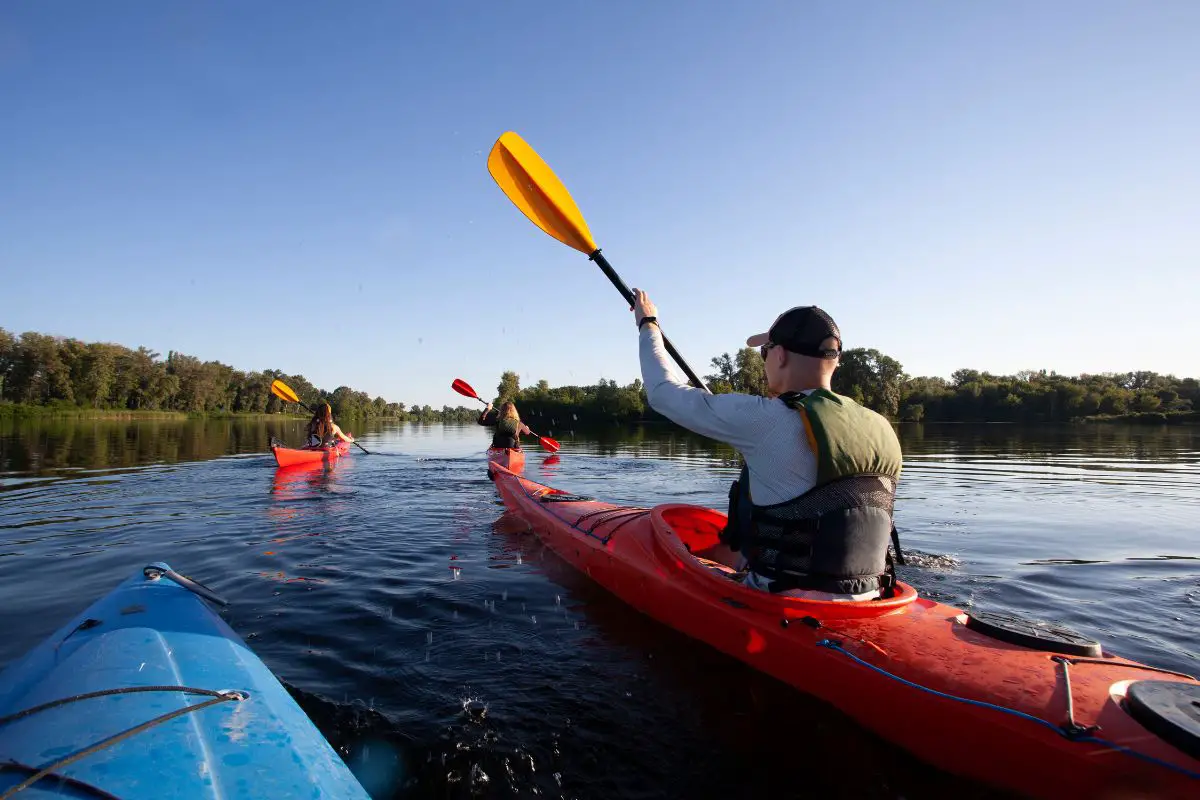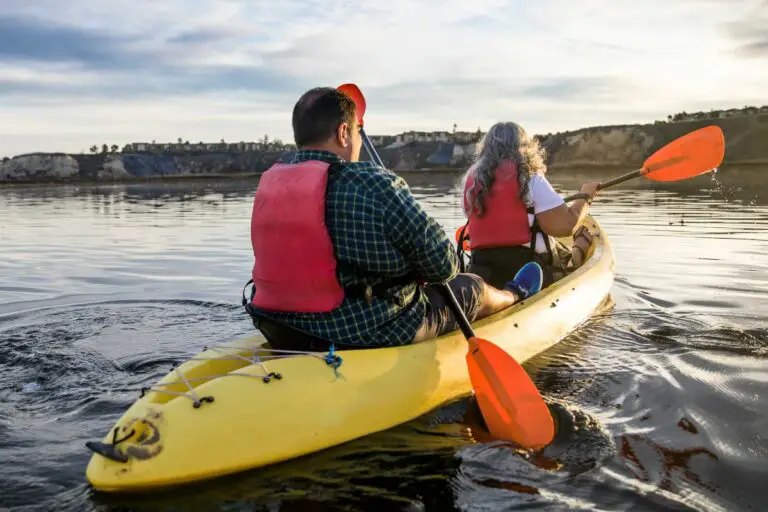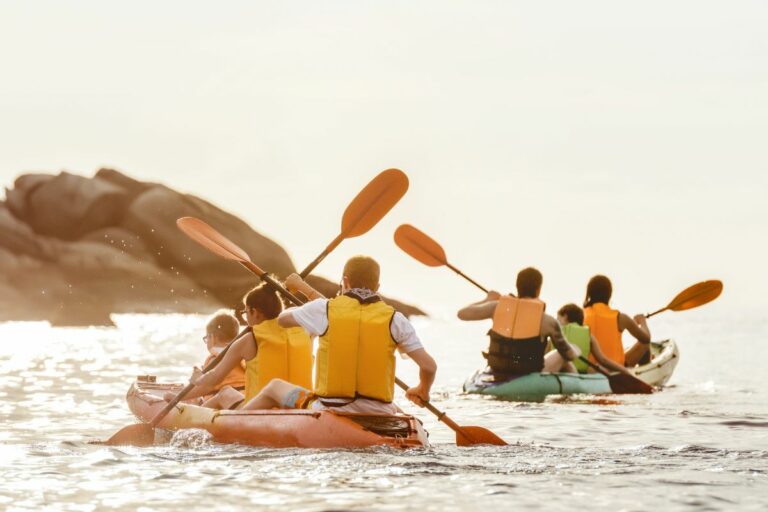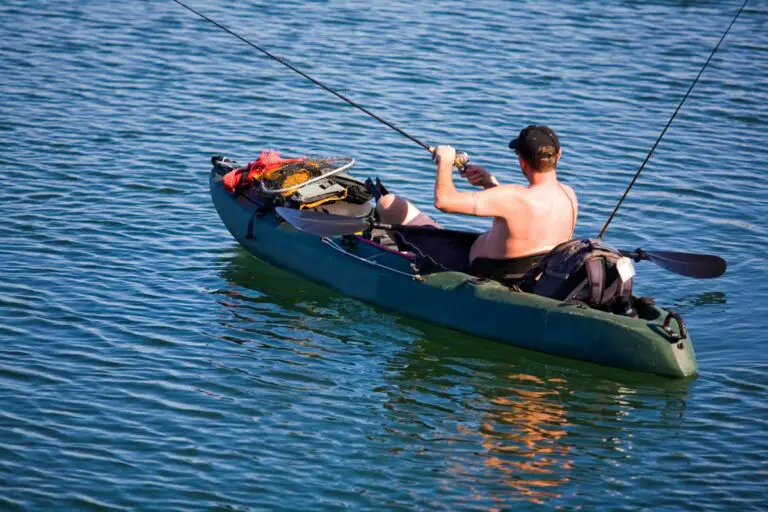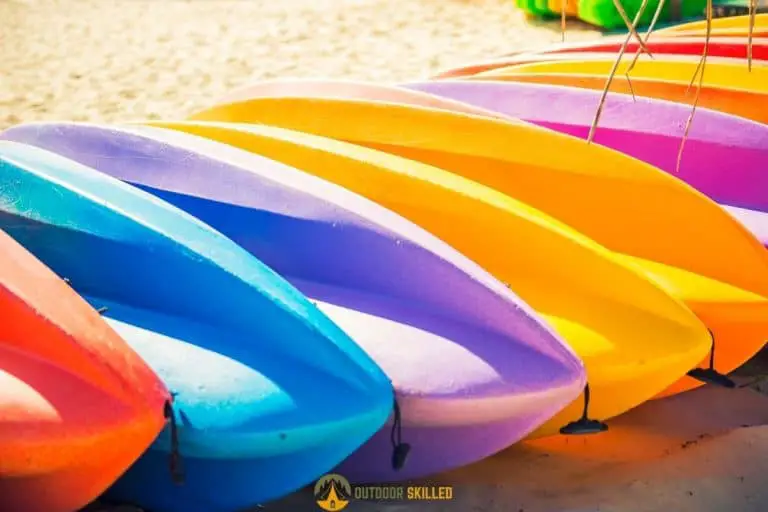Is Kayaking Hard for Beginners? 10 Things You Must Know
Kayaking is a popular water sport that offers a unique blend of adventure, exercise, and nature appreciation.
While kayaking is not hard, it still requires certain skills that take time to master, which may seem daunting at first. So, is kayaking hard for beginners?
Kayaking can be hard for beginners. However, with enough practice and patience, beginners can improve their technique and acquire the necessary skills to enjoy kayaking. It’s also important for beginners to choose the right kayaking equipment and learn the proper safety measures.
Keep reading to learn more about how hard kayaking is and what things every beginner should know about kayaking before getting started.
Table of Contents
How Hard Is Kayaking?

Kayaking can be considered moderately difficult, depending on the type of kayaking and the skill level of the individual.
Kayaking requires strength, balance, coordination, and proper paddling technique. It also demands good judgment, situational awareness, and decision-making skills, particularly in more challenging conditions like rapids or waves.
However, despite its initial difficulties, kayaking can be a rewarding experience that offers a sense of accomplishment and an opportunity to explore the outdoors in a new and exciting way.
Is Kayaking Hard for Beginners?
Kayaking can be challenging for beginners, especially those who are new to water sports and don’t have experience with balancing and maneuvering a kayak.
However, with enough practice and patience, even beginners can easily acquire the necessary skills to properly handle maneuvering a kayak and enjoy this thrilling water sport.
Is Kayaking Dangerous for Beginners?
Like any water sport, kayaking can be dangerous for beginners if proper safety precautions are not taken.
There are various risks associated with kayaking, particularly in more challenging conditions such as whitewater or open ocean paddling. For instance, inexperienced kayakers are often at risk of capsizing, hypothermia, or injury from collisions or obstacles.
However, by taking appropriate safety measures, such as wearing a personal flotation device (PFD) and paddling with more experienced kayakers, you can minimize these risks and safely enjoy the sport.
Do You Need to Be Fit to Kayak?
You do not need to be extremely fit to kayak; you need to have decent upper-body strength for paddling and core stability for balance and control.
While kayaking requires a certain level of physical fitness, the degree of fitness depends on the type of kayaking you will be doing.
For example, recreational kayaking on calm waters can be enjoyed by people of all fitness levels, and it can even be used as a low-impact form of exercise.
However, more demanding kayaking activities, such as whitewater or sea kayaking, require higher fitness and stamina.
It’s important to start at an appropriate level and gradually increase the intensity and duration of kayaking activities to improve fitness and reduce the risk of injury.
Do You Need to Take Lessons to Learn How to Kayak?
It is highly recommended to take lessons to learn how to kayak, especially if you are a beginner, as they can provide a structured approach to learning the basics of kayaking.
Instructors can help beginners develop proper paddling techniques, balance, and control, which can help prevent injury and make kayaking more enjoyable.
Lessons can also provide opportunities to learn about safety procedures, navigation, and rescue techniques critical to kayaking in more challenging conditions.
Even experienced kayakers can benefit from lessons to improve their skills and learn new techniques. However, it’s essential to do some research and choose a qualified instructor or program that meets your needs and skill level.
Is Kayaking Easier than Canoeing?
Kayaking and canoeing are two different paddling sports, each with its own set of challenges and rewards.
In general, kayaking can be considered more physically demanding than canoeing, as it requires more upper-body strength and a higher level of balance and coordination. Canoeing, on the other hand, might be more comfortable and stable, especially in calm waters, as it allows for a more relaxed and upright paddling position.
Ultimately, the best option for beginners depends on their personal preferences, the type of water they will be paddling on, and the goals they want to achieve through the activity.
10 Things Beginners Should Know About Kayaking

There are many things beginners should know before they start their kayaking adventure, from choosing the right kayak and equipment to learning different styles, techniques, and safety guidelines.
So, let’s break down everything beginners should know about kayaking in more detail:
Choosing the Right Kayak
There are several types of kayaks, each designed for different activities and water conditions.
Some common types of kayaks include:
| Kayak Type | Purpose |
| Recreational kayaks | These kayaks are designed for calm, flatwater paddling and are generally stable, easy to maneuver, and user-friendly for beginners. |
| Touring kayaks | These kayaks are designed for longer trips on open water and can handle rougher water conditions. They are typically longer and narrower than recreational kayaks, which can make them less stable but more efficient for longer paddling trips. |
| Whitewater kayaks | These kayaks are designed for navigating rapids and rough water conditions, and they are typically shorter and more maneuverable than other types of kayaks. |
| Sit-on-top kayaks | These kayaks are designed with an open cockpit and are ideal for warm weather and calm waters. They are typically more stable than other types of kayaks and can be easier for beginners to use. |
Recreational kayaks and sit-on-top kayaks are generally the best options for beginners, as they are stable, easy to maneuver, and less expensive than other kayak types. You can check out my recommendations for the best sit-on-top kayaks for beginners here.
Choosing the Right Paddle

Several types of kayak paddles are designed for different types of kayaking and personal preferences.
So, let’s take a closer look at some common types of kayak paddles and what type of kayaking they’re intended for:
| Paddle Type | Purpose |
| Low-angle paddles | These paddles are designed for longer, more relaxed paddling trips on calm waters, such as lakes or slow-moving rivers. They typically have a more gradual curve and a narrower blade, making them easier on the arms and shoulders. |
| High-angle paddles | These paddles are designed for more aggressive paddling on rough waters or in currents. They have a steeper blade angle and a wider blade, making them more efficient and powerful but also more physically demanding. |
| Wing paddles | These paddles are designed for racing and high-performance kayaking. They have a unique shape that provides greater speed and efficiency but requires a higher level of skill and experience to use effectively. |
| Touring paddles | These paddles are designed for longer trips on open water and can be used in a variety of water conditions. They typically have a longer, narrower blade for increased efficiency and are adjustable for different paddling styles. |
For beginners, a low-angle paddle is generally the best choice, as it is easier on the arms and shoulders and is suitable for a wide range of kayaking activities.
When choosing a paddle, it’s important to consider its length based on your height, the kayak width, and your paddling style. It’s a good idea to try out a few different paddles before purchasing one to ensure that it feels comfortable and easy to use.
Different Kayaking Styles
There are several different styles of kayaking; each requires different skills, equipment, and levels of experience.
So, let’s break down these kayaking styles in more detail:
- Recreational kayaking: This is the most common style of kayaking and is usually done on calm, flat water such as lakes or slow-moving rivers. It is typically done for leisure or exercise and requires no special skills or training.
- Touring or sea kayaking: Touring kayaking involves longer trips on open water, such as the ocean or large lakes. It requires more skill and experience than recreational kayaking and may involve navigating currents, waves, and wind.
- Whitewater kayaking: This style of kayaking involves navigating through fast-moving water and rapids. It requires advanced paddling skills, techniques, and specialized equipment such as a whitewater kayak, helmet, and protective gear.
- Surf kayaking: This style of kayaking involves riding ocean waves in a kayak. It requires advanced paddling skills and a specialized kayak designed for surfing.
- Kayak fishing: This is a popular style of kayaking that involves using a kayak for fishing in lakes, rivers, or the ocean. It requires some paddling skills as well as knowledge of fishing techniques and gear.
- Kayak racing: This style of kayaking involves racing against other kayakers on flat water or in whitewater. It requires advanced paddling skills and specialized equipment.
It’s recommended that beginners start with recreational kayaking and gradually progress to other styles as they gain skills and experience.
How to Enter a Kayak
If you’re a beginner, entering a kayak can be a bit intimidating at first, but with some practice, it can become second nature.
So, here’s a step-by-step guide on how to enter a kayak:
- Look for a calm and shallow area to enter your kayak. This will make it easier to get into the kayak without it tipping over.
- Hold your paddle horizontally across the kayak, with the blades resting on the shore or the bottom of the water.
- Stand next to the kayak with your feet shoulder-width apart and facing the kayak.
- Slowly lower yourself onto the edge of the kayak, keeping your weight centered and your hands on the paddle.
- Swing your legs into the kayak, one at a time, while holding onto the paddle for balance.
- Once you’re inside the kayak, adjust your seating position so that you’re comfortable and stable. You can use your paddle to help adjust your position.
- Push yourself off from the shore or the bottom of the water using your paddle, and start paddling.
Remember, feeling a bit unstable when you first get into the kayak is normal. Take your time, use your paddle for balance, and practice in a calm, shallow area until you feel more comfortable.
Improving Your Paddling Technique
Improving your kayaking paddling technique as a beginner can take some time and practice, but with the right approach, it’s definitely achievable.
Here are some tips to improve your kayaking paddling technique:
- Make sure you’re holding the paddle correctly, with your hands shoulder-width apart and your knuckles facing up. This will help you generate more power and control over your paddle.
- Focus on using your core muscles to power your paddle strokes rather than just your arms. This will help you generate more efficient and powerful strokes.
- Try to maintain a steady and consistent paddling pace rather than paddling too fast or too slow. This will help you maintain better control and efficiency in your paddling.
- Keep your body upright, with your back straight and your feet firmly planted on the footrests or bottom of the kayak. This will help you maintain balance and control while paddling.
- Take time to practice your stroke technique, focusing on proper blade placement, stroke angle, and follow-through. Start with slow, deliberate strokes and gradually increase your speed and power.
- Ask for feedback and tips from more experienced kayakers, or consider taking a kayaking lesson or clinic to improve your technique.
Self-Rescue Basics in Case of Capsizing
Learning self-rescue techniques is an important part of kayaking safety, especially for beginners. Here are some basic self-rescue techniques that beginners should learn in case their kayak capsizes:
Wet exit
A wet exit is the first step in any self-rescue situation. It involves flipping the kayak over and exiting it underwater.
To perform a wet exit, push off from the kayak, slide your legs out of the cockpit, and swim to the surface.
T-rescue
The T-rescue is a basic self-rescue technique that involves two kayakers. One kayaker provides support while the other re-enter the kayak.
The supporting kayaker creates a T-shape with their kayak and uses their paddle to stabilize the capsized kayak. The capsized kayaker can then re-enter their kayak from the back.
Eskimo roll
The Eskimo roll is an advanced self-rescue technique that requires more skill and practice but can be an effective way to quickly right a capsized kayak.
To perform an Eskimo roll, the kayaker rolls the kayak back upright while remaining inside it. This technique requires good body control and a well-fitted kayak.
Paddle float rescue
A paddle float rescue involves using a paddle float to stabilize the capsized kayak, allowing the kayaker to re-enter the kayak.
To perform a paddle float rescue, the kayaker attaches the paddle float to one end of the paddle and slides it onto the deck of the capsized kayak, creating an outrigger. They can then use the paddle float as a stabilizer while re-entering the kayak from the back.
It’s recommended to practice these self-rescue techniques in a controlled environment with a trained instructor. With practice, these techniques can become second nature and can help keep you safe while kayaking.
Appropriate Clothes for Kayaking
Wearing appropriate clothing while kayaking is important for both comfort and safety. Here are some tips on what to wear when kayaking:
- Quick-drying clothing: Wear clothing that dries quickly, such as synthetic materials like nylon or polyester. Avoid cotton clothing as it can stay wet for a long time, making you feel cold and uncomfortable.
- Wetsuit or drysuit: If you’re kayaking in colder water, consider wearing a wetsuit or drysuit to keep warm. A wetsuit will keep you warm by trapping a thin layer of water between your skin and the suit, while a drysuit keeps you completely dry.
- Sun protection: Wear a hat, sunglasses, and sunscreen to protect yourself from the sun. The reflection of the sun on the water can intensify the sun’s rays and cause sunburn.
- Footwear: Wear water shoes or sandals that can get wet and have a good grip on the kayak’s footrests or bottom. Avoid flip-flops or bare feet, as they can be slippery and unsafe.
- Rain gear: If there’s a chance of rain, bring rain gear, such as a waterproof jacket and pants, to keep you dry.
The appropriate clothing for kayaking may vary depending on the conditions, such as the temperature of the water and air, the weather, and the duration of the trip. So, it’s always a good idea to check the weather and plan accordingly.
Essential Safety Gear for Kayaking
Here’s a list of essential safety gear you need for kayaking:
- Personal Flotation Device (PFD): A properly fitted PFD is essential for kayaking. It can help keep you afloat if you fall in the water, and some PFDs have extra features such as pockets, whistles, or lights.
- Whistle: A whistle is a simple but effective way to signal for help in case of an emergency. Keeping a whistle attached to your PFD or clothing is a good idea.
- Bilge pump or sponge: A bilge pump or sponge can help you remove water from your kayak if it takes on water. It’s important to keep your kayak as dry as possible to avoid swamping or sinking.
- Spare paddle: A spare paddle can be a lifesaver if your main paddle breaks or becomes lost.
- Kayak paddle leash: A paddle leash can keep your paddle attached to your kayak in case you accidentally drop it in the water.
- Navigation and communication tools: Bring a map and compass or GPS device and a cell phone or VHF radio to communicate with others in case of an emergency.
- First aid kit: A small first aid kit can come in handy for minor injuries or accidents. Include items such as bandages, antiseptic wipes, and pain relievers.
- Dry bags: Use waterproof dry bags to keep your gear, food, and extra clothing dry. You can attach the dry bags to your kayak with bungee cords or straps.
- Kayak anchor: A kayak anchor can be used to keep the kayak in place in strong currents or windy conditions.
Remember, you need to be familiar with your safety gear and know how to use it in case of an emergency.
Transporting the Kayak
Transporting a kayak can seem daunting for beginners, but it can be done with a little planning and preparation. So, here’s how you can transport your kayak easily and safely.
- Check the weight of your kayak: Make sure you know the weight of your kayak and your vehicle’s weight capacity before loading it.
- Choose the right roof rack: If your vehicle doesn’t have a built-in roof rack, consider purchasing one that’s specifically designed for kayaks. You can also use foam blocks or cradles that attach directly to your roof.
- Load the kayak onto the roof: With the help of another person, lift the kayak onto the roof rack or foam blocks. Place the kayak upside down with the bow facing forward.
- Secure the kayak: Use straps to secure the kayak to the roof rack or foam blocks. Make sure the kayak is snug and won’t move during transport.
- Check for clearance: Make sure the kayak isn’t too high for your vehicle to fit under low-clearance areas like bridges or overpasses.
- Double-check the straps: Before hitting the road, double-check that the straps are secure and tight.
- Drive carefully: Kayaks can catch a lot of wind while driving, so drive at a moderate speed and be aware of your surroundings.
Here are the best options for transporting your kayak on your car:
Make sure to follow the manufacturer’s instructions for your specific roof rack or foam blocks, and never transport your kayak without proper tie-downs or support.
Storing and Maintaining the Kayak
Properly storing and maintaining your kayak is essential to ensuring its longevity and performance. Here are some tips for beginners on how to store and maintain a kayak:
- Clean your kayak after each use: Rinse off your kayak with fresh water after each use to remove any salt, dirt, or debris that can damage the kayak over time.
- Store your kayak in a dry and shaded area: Sunlight can fade the color of your kayak and cause it to become brittle over time. You can learn more about how to store your kayak here.
- Keep your kayak off the ground: Storing your kayak on the ground can cause it to become misshapen over time. Use a rack or cradle to keep the kayak off the ground.
- Avoid storing your kayak on its side: Storing your kayak on its side can cause it to become deformed over time. Store your kayak in a horizontal position.
- Check for any signs of damage: Regularly inspect your kayak for any signs of damage, such as cracks or punctures. Address any issues immediately to prevent further damage.
- Protect your kayak during transportation: Use a kayak cover or a tarp to protect your kayak during transportation.
By following these simple tips, you can ensure that your kayak stays in top condition for years to come.
Other Kayaking Tips for Beginners

Here are some other kayaking tips for beginners to make your experience safer, easier, and even more enjoyable:
- Always wear a personal flotation device (PFD): A PFD is essential for your safety, so make sure you wear it at all times.
- Practice in calm water: Start out in calm, flat water to get used to the kayak and the paddling techniques.
- Check the weather and water conditions: Before you go kayaking, check the weather and water conditions to make sure they are safe and suitable for your skill level.
- Bring plenty of water and snacks: Kayaking can be a workout, so make sure you bring plenty of water and snacks to stay hydrated and fueled.
- Don’t kayak alone: Always kayak with a friend or a group to ensure your safety.
- Be aware of your surroundings: Keep an eye out for other boats, buoys, and obstacles in the water to avoid collisions.
- Have fun and be respectful of the environment: Kayaking is a great way to connect with nature, so make sure you respect the environment and leave no trace.
Kayak your way to Freedom
- On a budget? Check out the best fishing kayaks under $500 here and the best Fishing Kayaks under $1,000 here. Or Check the best Cheap Kayaks here.
- Going fishing? Here are the best Ocean fishing kayaks, and here are the best River Fishing Kayaks.
- You can also find the best Fly Fishing Kayaks here and the best Bass Fishing Boats here.
- A bit experienced? Check out the best modular kayaks here and the best tandem fishing kayaks here.
- Looking for something special? Check out my favorite Ducky kayaks here.
- Navigate your way with these awesome and beginner-friendly Kayak compasses.
- Going Hunting? These Duck hunting kayaks will give you an unfair advantage!
- Have a need for speed? These motorized kayaks will get you moving.
- Protect yourself from the sun with these Kayak shades, and make your kayak more comfortable with these Kayak seats.
- Keep your feet dry and warm with these superb Kayaking shoes.
- Going Kayaking in cold water? Stay warm with these Kayaking gloves.
- Paddle Less, Fish More with the Best Kayak Motors
- Looking to get a trolling motor on your kayak? Check out the best kayak trolling motor mounts here.
If you like this article, please share it or pin it, you can find the share buttons below. We will really appreciate it ❤️

